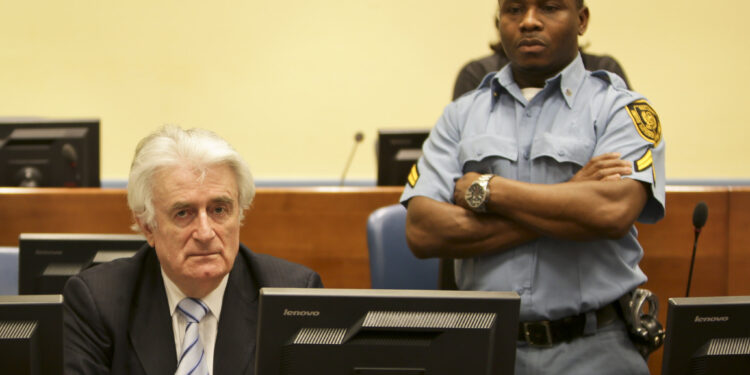A United Nations appeals chamber on Wednesday sentenced former Bosnian Serb president Radovan Karadžić to life in prison.
It found that the sentence of 40 years imprisonment imposed by the ICTY trial chamber for genocide, crimes against humanity and war crimes was “unreasonable and plainly unjust”.
Judges in national systems like England can look back on centuries of practice and precedent when they have to determine the appropriate sentence after convicting for a given crime. When the UN set up an international criminal court for the first time in 1993, the International Criminal Tribunal for the Former Yugoslavia (ICTY) that was based in The Hague, the Security Council defined which crimes the new ad hoc court would have jurisdiction for: war crimes, genocide and crimes against humanity.
But whereas national systems typically have criminal codes that list not only the crimes, but also indicate the sentences that can be imposed in case of conviction, the UN Security Council did no such thing. It only said that the ICTY could not impose the death penalty, as that would have been unacceptable for many UN member states as a matter of human rights. Developing a sentencing practice was left to the judges.
But in an international court judges always come from lots of different countries with different sentencing practices, so they would have different ideas about the sentence to be imposed. (In the Karadžić case, the appeals judges from Denmark, Tanzania and Uruguay decided to increase his sentence to life in prison, but the judges from Spain and Portugal dissented and voted against it.)
ICTY judges further dissented on the question of whether they should be bound by the sentencing practices in the former Socialist Federal Republic of Yugoslavia (SFRY), the country whose bloody disintegration led to the establishment of the ICTY. Some judges insisted on the importance of the old Roman rule: nullam poenam sine lege (no penalty without law). A citizen must be able to find in the law which sentence to expect on conviction for a crime. Other judges said they would just take ‘guidance’ from the SFRY sentencing practice, but were not bound by it.
For the young court, the absence of ‘tariffs’ and the conflicting ideas about what to do meant that people comparing judgments would often find the sentencing practice disproportionate, illogical, unreasonable and thus unjust.
In the Karadžić case, judges of the UN International Residual Mechanism for Criminal Tribunals (IRMCT), where judgments of the defunct ICTY can be appealed, compared the 40 years Karadzic got at the ICTY to the life sentences imposed to four of his subordinates for less crimes. Therefore a majority of three of the five appeal judges found the 40 years unreasonable and plainly unjust, given the “sheer scale” and “systematic cruelty” of the crimes for which he has been convicted.
During the 1992-1995 war in Bosnia-Hercegovina, more than 100,000 people were killed on all sides (Muslims, Serbs and Croats). That was the highest death toll in any war in Europe after the Second World War.
The Bosnian civil war broke out after the Muslim majority voted in a referendum to secede from the SFRY. The Bosnian Serbs were afraid to become a minority in a Muslim-dominated state and voted in turn to secede from Bosnia. Republika Srpska comprises territories predominantly inhabited by Serbs.
After the fall of Srebrenica on July 11, 1995, Karadzic’s Bosnian Serb troops slaughtered thousands of Muslim men and boys. The massacre is the only genocide in Europe after the Second World War recognized as such by UN courts. In Africa, the International Criminal Tribunal for Rwanda (ICTR) in Arusha (Tanzania) convicted suspects for the 1994 genocide.







